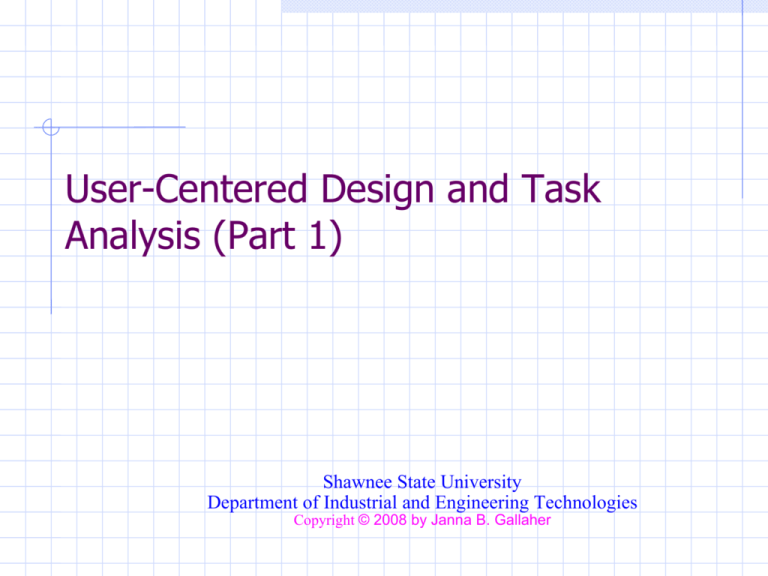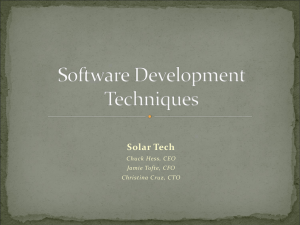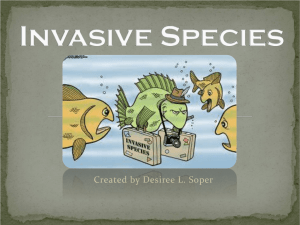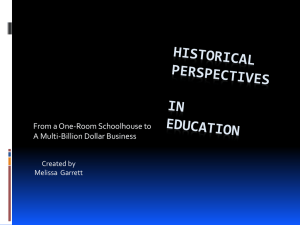Lecture7-UserCentere..
advertisement

User-Centered Design and Task Analysis (Part 1) Shawnee State University Department of Industrial and Engineering Technologies Copyright © 2008 by Janna B. Gallaher What is User Centered Design User-centered design (UCD) is an approach to design that grounds the process in information about the people who will use the product. UCD processes focus on users through the planning, design and development of a product. http://www.usabilityprofessionals.org/usability_resources/about_usability/what_is_ucd.html Four main activities in user centred design: Specify the context of use Specify the requirements Create design solutions Evaluate designs Design Approaches The process of design Devise concepts and metaphors Develop screen flow and navigational model Create low-fidelity prototype designs Conduct usability testing on low-fidelity prototypes Create high-fidelity detailed design Do usability testing again Document standards and guidelines Create a design specification Design Approach: Graphic Design Basics http://www.digital-web.com/articles/principles_of_design/ Principles: Balance, Rhythm, Proportion, Dominance, Unity Typography http://www.webmonkey.com/webmonkey/design/fonts/tutorials/tuto Color http://www.layoutgalaxy.com/html/htmnewletter9-page1.htm Design Approach: Alternative System Development Processes Lifecycle model (SDLC – system development life cycle) “One [well-known] study found that 80 percent of software life-cycle costs occur during the maintenance phase. Most maintenance costs are associated with “unmet or unforeseen” user requirements and other usability problems.” http://searchsoftwarequality.techtarget.com/sDefinition/0,,sid92_gci755068, General Steps: Evaluate existing system Define new system requirements Design new system Develop new system Put new system to use Evaluate after implementation Maintain system Various SDLC Methodologies Waterfall model Rapid application development model Joint Application development Fountain Model Spiral Model Build and Fix Synchronize-and Stabilize Design Approach: Alternative System Development Processes Waterfall model A sequential software development model in which development is seen as flowing steadily downward through each phase. Each phase must be 100% complete before moving on to the next phase. http://en.wikipedia.org/wiki/Waterfall_model Phases of the waterfall model: Requirements analysis Design Construction Integration Testing and debugging Installation Maintenance Design Approach: Alternative System Development Processes Participatory design http://www.infodesign.com.au/ftp/ParticipatoryDesign.pdf Gives users a voice in the design process Enables technical and non-technical participants to participate equally Provide an opportunity for developers to meet, work with an understand their users Provide a forum for identifying issues Provide an opportunity to get or enhance user buy-in. Are highly productive Use techniques which can be easily learned and applied in future activities. Design Approach: Alternative System Development Processes (continued) Iterative design User interfaces should be designed using an iterative approach since almost no interface can be flawless from the start. http://www.useit.com/papers/iterative_design/ Involves steady refinement of the design based on user testing and other evaluation methods. Problems encountered in one iteration are fixed and then another iteration is evaluated Design Approach: Task Analysis Techniques http://en.wikipedia.org/wiki/Task_analysis The analysis of how a task is accomplished, including a detailed description of both manual and mental activities, task and element durations, task frequency, task allocation, task complexity, environmental conditions, necessary clothing and equipment, and any other unique factors involved in or required for one or more people to perform a given task. Design Approach: Design Specification Techniques http://www.cmcrossroads.com/bradapp/docs/sdd.html#TO A template used to frame the specification Design Approach: Design Analysis Techniques Objects and actions http://www.cs.umd.edu/class/fall2002/cmsc838s/tichi/oai.h As Graphical User Interfaces (GUI) are replacing the text mode command based languages, the concern is now shifted to the visual representation and display of the user's tasks objects and actions. e.g. “...the Object-Action model maps to real life environment. If you want to move a paper from a folder to another, you simply start by selecting the paper you will move not by initiating a move action and then selecting the paper.” Social Organization and Work Relates to the human as an interacting social being Includes a concern with the nature of work Concerned with the notion that human systems and technical systems mutually adapt to each other and must be considered as a whole. Social Organization: Points of View Industrial engineering Concerned with people and systems http://en.wikipedia.org/wiki/Industrial_engineering Operations research Using mathematical modeling techniques to characterize systems http://en.wikipedia.org/wiki/Operations_research Rasmussen's cognitive engineering http://www.mie.utoronto.ca/labs/cel/research/frameworks/cwa.htm Instead of describing what workers should do (normative) or what they presently do (descriptive), CWA is formative, describing what workers could do to achieve work purposes. Aarhus participatory design approach http://www.daimi.au.dk/research/areas/human-computer-interaction Social Organization: Points of View Hewitt's open systems Carl Hewitt: http://en.wikipedia.org/wiki/Carl_Hewitt#_note-hewitt1973 Model of a society of experts communicating to supplement the model of a single very intelligent human being http://www.cypherpunks.to/erights/history/actors/AIM-410.pdf Virtual processors or streams that act as objects which represent a function or process http://dli.iiit.ac.in/ijcai/IJCAI-73/PDF/027B.pdf Social Organization: Models of Human Activity Opportunistic planning Open procedures Human-Computer Communication http://www.csdl.tamu.edu/~zacchia/research/Readings/books/Plans





